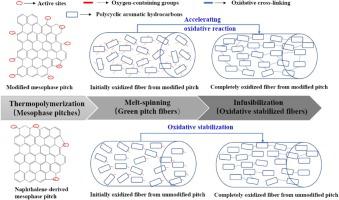Journal of Analytical and Applied Pyrolysis ( IF 6 ) Pub Date : 2020-12-30 , DOI: 10.1016/j.jaap.2020.105009 Zhao Jin , Xiaohua Zuo , Xiangyi Long , Zhengwei Cui , Guanming Yuan , Zhijun Dong , Jiang Zhang , Ye Cong , Xuanke Li

|
A spinnable mesophase pitch with 95 vol.% optical anisotropy and 267 °C softening point was prepared through co-polymerization of 95 wt.% naphthalene pitch and 5 wt.% C9 resin. The effects of introducing C9 resin on the formation, structure and properties of naphthalene-derived mesophase pitch and the oxidative stabilization of resulting pitch fibers as well as the final physical properties of carbon fibers were systematically investigated. The results suggest that C9 resin could effectively facilitate the generation and development of liquid crystals in synthetic naphthalene pitch during the heat soaking process and introduce a certain amount of methyl side chains linking in polycyclic aromatic hydrocarbon molecules, so as to reduce the melt viscosity of modified mesophase pitch and improve its flow-spinnability and oxidative reaction capability. The pre-oxidation process of the modified pitch-spun fibers could be completed ahead of 4 hrs at 240 °C in an air atmosphere, compared with unmodified pitch fibers. This shows a possibility to decrease the production cost of mesophase pitch-based carbon fibers. Although the tensile strength of 1000 °C carbonized fibers prepared from the modified mesophase pitch (1.23 GPa) is slightly higher than that of original carbon fibers (1.18 GPa), the axial electrical resistivity and the thermal conductivity of corresponding graphite fibers after 3000 °C graphitization are 2.0 μΩ·m and 677 W/(m·K), respectively, which are significantly enhanced in comparison with those of original graphite fibers (3.2 μΩ·m and 473 W/(m·K)).
中文翻译:

通过使用C9树脂改性萘基中间相沥青来促进沥青纤维的氧化稳定化并改善碳纤维的物理性能
通过95重量%的萘沥青和5重量%的C9树脂的共聚制备具有95体积%的光学各向异性和267℃的软化点的可纺中间相沥青。系统研究了引入C9树脂对萘衍生的中间相沥青的形成,结构和性能以及所得沥青纤维的氧化稳定性以及碳纤维最终物理性能的影响。结果表明,C9树脂可以有效地促进热浸过程中合成萘沥青中液晶的产生和发展,并在多环芳烃分子中引入一定量的甲基侧链,从而降低改性胶的熔融粘度。中间相沥青并提高其流动纺丝性和氧化反应能力。与未改性沥青纤维相比,改性沥青纤维的预氧化过程可以在空气中于240°C下于4小时之前完成。这表明降低中间相沥青基碳纤维的生产成本的可能性。尽管由改性的中间相沥青(1.23 GPa)制备的1000°C碳化纤维的抗张强度略高于原始碳纤维(1.18 GPa)的抗张强度,但3000°C后相应石墨纤维的轴向电阻率和导热系数石墨化度分别为2.0μΩ·m和677 W /(m·K),与原始石墨纤维(3.2μΩ·m和473 W /(m·K))相比显着增强。与未改性沥青纤维相比。这表明降低中间相沥青基碳纤维的生产成本的可能性。尽管由改性的中间相沥青(1.23 GPa)制备的1000°C碳化纤维的抗张强度略高于原始碳纤维(1.18 GPa)的抗张强度,但3000°C后相应石墨纤维的轴向电阻率和导热系数石墨化度分别为2.0μΩ·m和677 W /(m·K),与原始石墨纤维(3.2μΩ·m和473 W /(m·K))相比显着增强。与未改性沥青纤维相比。这表明降低中间相沥青基碳纤维的生产成本的可能性。尽管由改性的中间相沥青(1.23 GPa)制备的1000°C碳化纤维的抗张强度略高于原始碳纤维(1.18 GPa)的抗张强度,但3000°C后相应石墨纤维的轴向电阻率和导热系数石墨化度分别为2.0μΩ·m和677 W /(m·K),与原始石墨纤维(3.2μΩ·m和473 W /(m·K))相比显着增强。


























 京公网安备 11010802027423号
京公网安备 11010802027423号